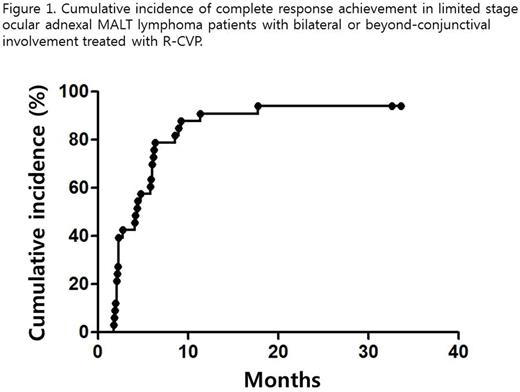Abstract
Background: Ocular adnexal mucosa-associated lymphoid tissue lymphoma (OAML) has an indolent disease course and a generally good response to radiotherapy; hence, limited-stage disease is commonly treated with radiotherapy. However, after localized radiotherapy for limited-stage OAML, a relapse rate of up to 16% was reported and the main relapse sites observed in previous series were in nonirradiated areas. The relapse rate was higher if the disease involved bilateral conjunctivae or tissue beyond the conjunctiva. We designed a phase II study in which patients with newly diagnosed and limited-stage OAML with bilateral or beyond-conjunctival involvement were treated with a regimen of rituximab in combination with cyclophosphamide, vincristine, and prednisolone (R-CVP), which has been widely used for advanced-stage indolent CD20+ B cell lymphoma and in a previous trial has demonstrated efficacy in advanced-stage MALT lymphoma.
Patients and methods: Thirty-three patients with Ann Arbor stage I OAML with the adverse factors were enrolled. Patients received six cycles of R-CVP followed by two cycles of rituximab therapy. The enrolment criteria for disease status were Ann Arbor stage IE OAML with bilateral or beyond-conjunctival involvement; bT1 or T>1 based on the tumor-node-metastasis (TNM) staging system for ocular adnexal lymphoma proposed by the American Joint Committee on Cancer. Patients were required to be ©ø18 years old, with Eastern Cooperative Oncology Group (ECOG) performance scores of 0-2, with no prior chemotherapy or radiation therapy. Exclusions were made for disease confined to unilateral conjunctiva (T1N0M0) or Ann Arbor stage III-IV disease. The primary end point of the study was response rate, defined as the CR and partial response (PR) rates, based on the revised response criteria for malignant lymphoma. The secondary end point was PFS and overall survival.
Results: The median age of the patients was 49 years (range, 19-74 years). The anatomic location of disease was the conjunctiva in 12 patients (36.4%), the orbit in 13 (39.4%), the eyelid in five (15.2%), and the lacrimal duct or gland in three (9.1%). Fourteen patients (42.4%) had bilateral disease at presentation. All study patients (100%) responded to the treatment. After the treatment, 28 patients (84.8%) were in CR and five patients (15.2%) in PR. With the median follow up of 26.9 months (range, 7.4-41.0 months), the estimated cumulative CR rate was 93.9% at 3 years (Figure 1). The cumulative CR rate was significantly lower in the patients with beyond-conjunctival disease (T>1) than in the patients with bilateral conjunctiva-confined disease (bT1) (91.3% vs. 100%; P = 0.022). The cumulative CR rate was lower for patients aged ©ø49 than in patients younger than 49 years (90.4% vs. 100%; P = 0.034). Multivariate analysis indicated that in our study patients beyond-conjunctival involvement (T>1) was an independent predictor of cumulative CR rate (hazard ratio [HR] 0.424, P = 0.044). Among the study patients, one patient, who had bT1N0M0 disease, relapsed at the same location in the eye at 21.7 months after initiation of treatment. The estimated PFS at 3 years was 95.5 ¡¾ 4.4%. No death was observed and OS was 100%. No patients experienced ophthalmic complications (Figure2).
Conclusions: The R-CVP regimen was efficient for disease control up to 3 years because all study patients responded, cumulative CR rate was 93.9% and the PFS was 95.9% at 3 years. The common relapse sites in patients who received radiotherapy were in nonirradiated areas, suggesting that the systemic antitumor coverage of this chemoimmunotherapy may contribute to lowering the risk of distant relapse in our patients. We conclude that the R-CVP regimen can be effective alternative treatment which avoids radiation hazards and efficiently achieves CR in patients with limited-stage OAML, even those with adverse factors of radiotherapy.
No relevant conflicts of interest to declare.
Author notes
Asterisk with author names denotes non-ASH members.



This feature is available to Subscribers Only
Sign In or Create an Account Close Modal